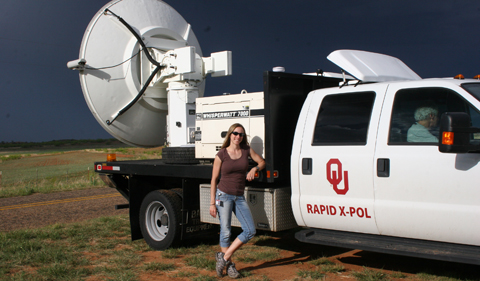
Dr. Jana Houser with University of Oklahoma’s Rapid-scan, X-band, polarimetric mobile radar (RaXPol).
Research by Dr. Jana Houser showing tornadoes forming from the ground up, with implications for tornado predictions, was featured in several prestigious news outlets.
Houser presented new research at the American Geophysical Union’s conference that showed the commonly-held theory that tornadoes spawn from the clouds down is likely incorrect. In each case she studied using new technology, she found that tornadoes actually start at the ground and move upward – which means forecasters are looking in the wrong place when looking to issue tornado warnings. The story was picked up broadly, including on broadcast outlets and internationally.
“We need to reconsider the paradigms that we have to explain tornado formation, and we especially need to communicate this to forecasters who are trying to make and issue warnings,” said Houser, Assistant Professor of Geography at Ohio University and co-author of the new study. “Based on our results, it does not look like you are going to really ever be finding strong evidence of a tornado descending, so we need to stop making that a priority in our forecasting strategies.”
The Washington Post report was headlined “Tornadoes spawn from cloud to ground, right? Probably not, says this new study.”
New research could help reshape how we think tornadoes form.
The study, presented Thursday at the American Geophysical Union annual meeting in Washington, expands on previously published work that investigated the massive El Reno tornado in 2013. It had winds up to 300 mph, and was the widest tornado ever observed. It killed several storm chasers. And it is one of the most-studied tornadoes of the past five years.
When Jana Houser and her colleagues looked back at the data, they noticed something they hadn’t observed before — instead of starting in the clouds and dropping to the ground, the tornadoes they examined appeared to have started at the ground and worked their way up. The 2013 El Reno tornado was among these. In all, they found five cases in which their radars detected that signature. It’s a small sample size, but it could prove invaluable to the severe-weather research community.
Live Science reports that “Tornadoes Don’t Form Like Meteorologists Thought They Did.”
Picture a tornado forming. Does the funnel cloud in your mind’s eye reach down from the sky like a malicious, spindly finger?
If so, that mental picture may be all wrong. New research suggests that tornadoes form not from the clouds down, but from the ground up.
In a new study presented yesterday (Dec. 13) at the annual meeting of the American Geophysical Union in Washington, D.C., Ohio University meteorologist Jana Houser argued that of four tornadoes observed in enough detail with a rapid radar technique, not a single one started its rotation in the sky. Instead, Houser and her team found, the tornado rotation began rapidly near the ground. [25 Strangest Sights on Google Earth]
“Tornadoes do not appear to form from the traditional, top-down mechanism,” Houser told reporters at a news briefing.
Science Magazine reports “Forecasters may be looking in wrong place when predicting tornadoes, Ohio research shows.”
ATHENS, Ohio (Dec. 20, 2018) – Weather forecasters may be looking in the wrong place when working to issue tornado warnings, new research led by Ohio University has demonstrated.
Historically, there have been a wide number of conflicting theories about how tornadoes form, but the most widely accepted was that they form from the top down, based on work done from the 1970s through the 1990s. For the first time, new observational evidence shows that they actually form from the ground up, which could have a profound impact on the way tornado warnings are issued in the future. It’s the first time these hypotheses have been able to be evaluated observationally, thanks to a modern radar system that collects data very rapidly.

















Comments